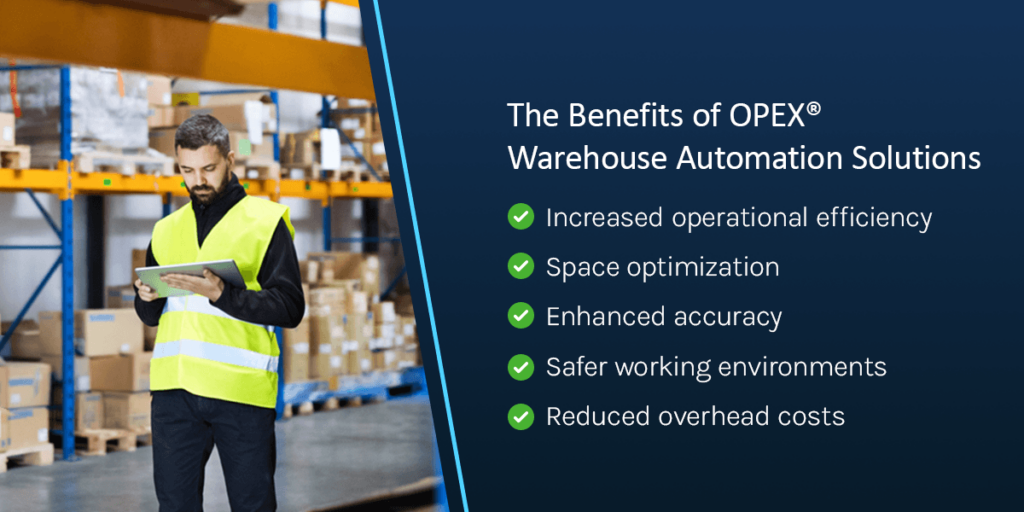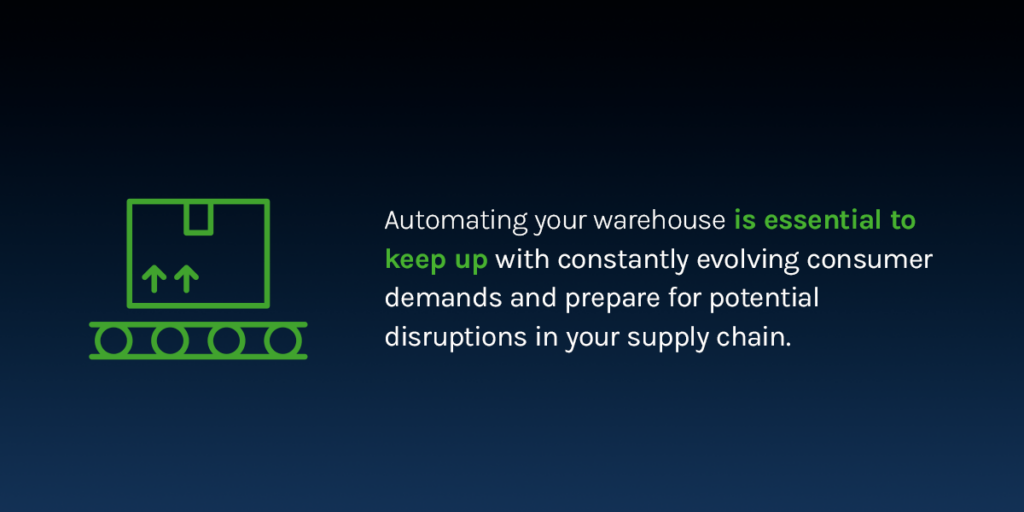How to Seamlessly Integrate Warehouse Automation with Your Current Operations
15 min read
60-Second Summary
Warehouse automation streamlines operations by using robotics, software, and equipment to optimize how inventory is moved, stored, and handled—reducing costs, improving order fulfillment, and creating a safer work environment. Before diving in, assess your warehouse’s technological readiness, order volume fluctuations, and labor challenges to determine automation fit. Begin with a workflow analysis to pinpoint inefficiencies and set performance goals. Select scalable tools like AS/RS, G2P systems, AGVs, and automation software that suit your current needs and future growth. Seamlessly integrate these with existing systems—starting with a WMS—and test functionality before full rollout. Train employees for evolving roles and use their feedback to improve outcomes. Automation success depends on clear goals, the right tools, and a culture open to change.
Automating your warehouse provides many benefits, ranging from increased efficiency and throughput to reduced overhead expenses. Proper planning is crucial to integrate these technologies with your current operations to reap the full rewards of automation. Prepare for warehouse automation with the right considerations and steps.
Understanding Warehouse Automation
Warehouse automation involves using equipment, robotics, and/or software to automate routine activities related to moving inventory in and out of warehouses, distribution centers, and other similar spaces. With these technologies, businesses can optimize inventory handling to decrease overhead expenditures and fast-track order fulfillment, distribution, or replenishment.
Automation eliminates the need for employees to perform repetitive tasks, including those related to receiving, picking, packing, or shipping. Workers then have more time to focus on activities that require critical thinking and problem-solving skills. Automation also reduces the risk of injury and helps employees combat fatigue.
Manual processes are linked to high error rates. Using automation can save money by minimizing employee mistakes when capacity and throughput increase.
You may already use an automation tool to help enhance your operation’s efficiency and output, such as a warehouse management system (WMS) to monitor and streamline daily processes. In fact, 39% of organizations already benefit from tools like artificial intelligence (AI) that increase employee productivity. The warehouse automation market is predicted to reach $54.53 billion by 2029, and by 2030, the adoption rate of robotics and automation is expected to reach 85%.
There are two main categories of warehouse automation technologies:
- Physical warehouse automation: This type of warehouse automation includes robotics, conveyors, and equipment to make material handling workflows more efficient and reduce manual input for labor-intensive activities.
- Digital warehouse automation: This category involves software used in warehouses to perform more mentally demanding tasks such as automatic identification, data capture, radio frequency identification, and barcode reading.
Automating your warehouse is essential to keep up with constantly evolving consumer demands and prepare for potential disruptions in your supply chain.
What to Consider Before Automating Your Warehouse
Integrating warehouse automation tools with your existing workflows requires a strategic approach. Consider the following factors:
- Technological readiness: Assess whether your current infrastructure and technologies can support automation. If your shipping software or WMS needs to be updated, prioritize this first and then focus on adding more advanced tools. Some warehouse automation companies can also provide a full turnkey solution, including equipment, conveyors, and software.
- Order volumes: For warehouses that experience dramatic increases in demand, either unexpectedly or during peak seasons, automation offers flexibility to upscale or downscale without changing staff numbers. Implementing automation can help ensure your operation is prepared for increased order volumes.
- Product diversity: If your warehouse handles various products with different weights, sizes, and storage needs, automation can help simplify complex storage organization and material handling workflows.
- Worker costs and availability: Automated systems help solve hiring challenges or high labor costs. Implementing automation technologies may also mitigate labor shortage issues and high turnover rates.
- Worker safety: Automation facilitates a safer working environment and lowers the risk of occupational hazards by minimizing monotonous, physically strenuous, or potentially dangerous activities or tasks.
If your warehouse operation is a good candidate for automation, you should define your goals for these workflows. This might include minimizing operating expenses, improving operational efficiency, or meeting consumer demands. Establishing your objectives early guides implementation.
How to Implement Warehouse Automation![]()
Implementing warehouse automation is a significant undertaking at every scale. Whether you want to introduce or upgrade automated tools and technologies, the following steps are necessary to integrate them with your current operations.

1. Conduct a Workflow Analysis
Determine your warehouse’s primary challenges to analyze your workflow. These could include order fulfillment delays, inaccurate shipments, or high labor costs. Collecting and reviewing data regarding your operation’s current supply chain and daily activities can help identify areas for improvement. Providers such as OPEX® also offer in-depth workflow analysis services, providing a thorough evaluation of your operations and needs.
Next, assess your existing operational procedures to determine where automation could enhance workflows and efficiency. These major processes can be optimized with warehouse automation technologies:
- Inventory receiving and replenishment
- Item sorting and distribution
- Order picking, packing, and shipping
- Returned order handling and merchandise
During this step, you should define key performance indicators (KPIs) to measure the success of your automation efforts at a later stage.
2. Select the Right Warehouse Automation Tools
Your automation strategy can consist of digital tools and/or physical tools. Based on your workflow analysis and objectives, research which tools and technologies align with your current operational needs. You should also consider future growth — the solution you choose should provide the scalability and flexibility needed to expand operations.
Review the different types of automated systems to find the right solution:
- Automated storage and retrieval systems (AS/RS): These systems encompass various technologies, including robots, shuttles, mini loaders, and goods-to-person systems, to store and retrieve inventory. AS/RS is a popular choice as it reduces labor expenses, streamlines operations, and improves space utilization.
- Goods-to-person systems (G2P): This is a type of AS/RS that includes the use of conveyors, lift systems, robots, or carousels to deliver products or materials to workers. G2P systems eliminate the need to spend time locating goods, increasing warehouse picking efficiency.
- Automated guided vehicles (AGVs): These vehicles move around warehouses on predefined routes made from wires, magnetic strips, or sensors. AGVs can be used in AS/RS or G2P systems, delivering goods or completing other routine activities in a system.
- Automated sortation systems: This technology automatically sorts items based on preset parameters or in accordance with order fulfillment, replacing standard put-wall sorting. It can be used for various applications, including e-commerce order fulfillment, returns processing, cross-docking, or parcel sortation.
- Automation software: Along with a WMS, automation software includes inventory management and order fulfillment software. While a WMS can be used to oversee a warehouse’s logistics, supply chain, and operations, inventory management software functions allow you to monitor inventory and stock levels. Order fulfillment software focuses on the order fulfillment aspect of inventory management, from picking to shipping and tracking.
3. Integrate With Your Existing Systems
Seamless integration between your existing and future systems is essential to connect all areas of your warehouse’s operations. Before committing to new tools and technologies, perform a pilot test to assess how well they fulfill your needs.
If you still need to implement a WMS, introduce this software before integrating more advanced automation solutions, such as G2P systems, or work with an integrator who can provide the software and equipment pieces. Consider the design of your warehouse to determine if an automated system is appropriate. Some physical automation tools are only suitable for warehouses with specific layouts. For example, AGVs might not be appropriate for small spaces with complex setups as they need space to navigate.
Redesigning your warehouse is possible, but complexity and costs may rise. This makes it crucial to implement a solution that will provide an ROI.
4. Implement and Test Your Warehouse Automation Tools
Create a thorough implementation plan once you’ve confirmed the compatibility between current and new systems. A phased installation can help you avoid excessive disruption to continuing operations.
After installation, verify whether your system functions as expected. Make adjustments to refine your operations as needed. Using the KPIs identified in the first step, continue to monitor system performance against your objectives. Continuous improvement helps you maximize your warehouse automation.
5. Train and Prepare Your Employees
Warehouse automation will impact your employees’ roles and responsibilities. These technologies can offer career development opportunities, improve recruitment, and increase retention.
When deciding which processes to automate, consider your human workforce and restructure their roles if needed. Invest in training and upskilling programs to help operators adapt to new automation tools.
Collect employee and management feedback to identify shortcomings or suggestions for improvement. Frequently reviewing these insights can help enhance your warehouse’s use of automation. Effective warehouse automation is possible with an adaptable culture and ongoing learning opportunities.
The Benefits of OPEX® Warehouse Automation Solutions

Properly integrating warehouse automation with your existing processes can maximize the benefits, like boosting efficiency and improving throughput. Partnering with a trusted warehouse automation provider like OPEX is crucial to achieving the desired outcome.
Key advantages of implementing OPEX’s automation solutions include:
- Increased operational efficiency: OPEX’s order fulfillment systems are designed to optimize tasks related to picking, packing, shipping, and returns, speeding up workflows and minimizing human errors. For example, one of our customers has seen a fivefold increase in orders picked per employee per hour. These systems continuously function, increasing productivity while keeping downtime to a minimum.
- Space optimization: Implementing automated solutions such as Sure Sort®, Sure Sort X®, Perfect Pick®, and Infinity® optimizes space, as our systems have a compact footprint and utilize vertical space. Sure Sort and Sure Sort X can replace as many as six manual putt walls. Another OPEX customer has achieved a 77% reduction in floor space.
- Enhanced accuracy: With Perfect Pick and Infinity’s precision, you can reduce picking mistakes while improving customer satisfaction. Sure Sort and Sure Sort X’s cutting-edge sorting technology also helps minimize mistakes associated with manual sorting and cross-docking.
- Safer working environments: AS/RS solutions eliminate the need for repetitive and heavy lifting, helping to reduce physical strain on employees.
- Reduced overhead costs: OPEX’s automated systems minimize overhead expenses by reducing the need for manual labor. For added automation, Sure Sort X with Xtract™ effortlessly sorts and transfers completed orders, helping alleviate employee shortages and decrease labor costs. One of our customers has seen a 65% reduction in the labor required.
Automate Your Warehouse With OPEX
With nearly 50 years in business, OPEX is the next generation of automation, engineering award-winning solutions that can transform your operations. Our systems are flexible and modular and can be configured to meet your operation’s unique requirements. Integrating OPEX’s automation solutions with your current operations helps overcome barriers related to order fulfillment, reverse logistics, cross-docking, and parcel management applications.
OPEX offers comprehensive services to support you through each implementation stage, including workflow analysis, installation and system implementation, and employee training. Your operations are our number one priority — we offer 24/7 support and preventive maintenance performed by our in-house technicians.
To learn more about how OPEX’s solutions can optimize your operation, contact us today.
Other Resources You Might Find Helpful
What is Right-Speed Scanning?
Modernizing ECM/RIM Workflows: The Hidden Costs of Inefficiencies
OPEX® Falcon+® RED® One-Touch Scanning Envelope Opener
Gemini™ Right-Speed Scanner
How Intelligent Scanning Cuts Costs and Drives ROI for BPOs
Portsmouth, VA Treasurer’s Office Goes from Cost Center to Revenue Center
Falcon® Scanner Demo
Konica Minolta’s Competitive Edge: Streamlining Document Workflows with OPEX® Technology
Timaru District Council (TDC) Launches into a Digital World
Built for Compliance: How Modern Scanning Systems Deliver Operational Excellence
NEXT LEVEL AUTOMATION
Unlock Operational Efficiency with OPEX
OPEX is powering the future of automation. Contact us to learn more about how our vertically integrated automated solutions can help take your business to new heights.

